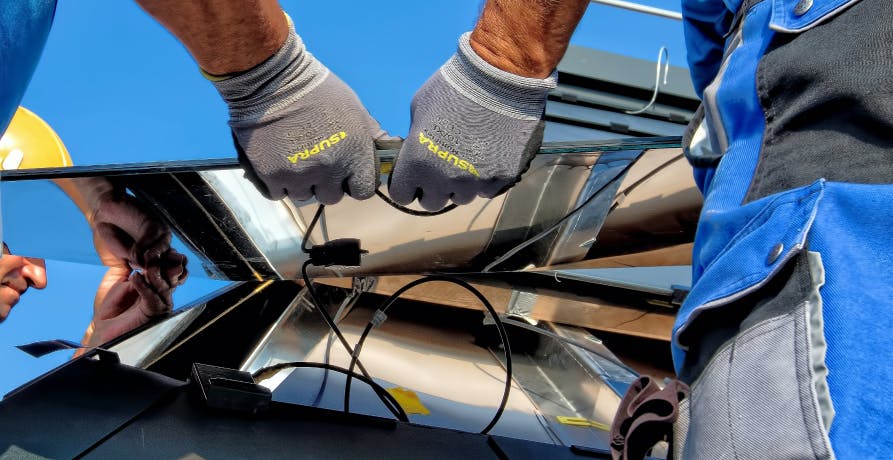ESG / CSR
Industries
The Debate on Solar Radiation Modification



Whenever you're searching for your sunglasses, shopping for a new summer hat, or looking to slather on sunscreen before heading to the beach – we’ve all learned the importance of protecting ourselves from solar radiation, otherwise known as sunlight.
It’s no secret that many areas of the world have had warmer and sunnier summers in recent years in combination with climate change. As a result, a massive debate has arisen regarding solar radiation – making it one of the most controversial topics when it comes to developing climate policy.
In this article, we’ll explore the debate on solar radiation, what are the pros and cons to each side, and how the world can work together to find a common ground.
What is Solar Radiation and the current debate?
Solar radiation, more commonly known as sunlight – refers to the electromagnetic radiation created from the sun. Solar radiation can (and already has) prove useful in the midst of efforts to conserve energy and reduce electricity consumption, as solar radiation can be converted into usable energy.
👉 Popular examples include a solar powered smartphone chargers, headphones, or speakers.
Despite the potential to harness solar radiation, it can be difficult to arrange the technology and finances necessary to develop effective solar farms. In addition to this, not everywhere on Earth is sunny every day of the year – with geographic location, season, and time of day remaining essential points to consider when seeking to make use of solar radiation and energy.
Solar Radiation Modification, or SRM, is a set of methods and technologies which would work together to purposefully alter the Earth’s climate. This would be achieved by reflecting part of the sun’s energy away from Earth or by adjusting how solar radiation works with our atmosphere.
Ultimately, the main goal of Solar Radiation Modification would be to avoid the effects of climate change – especially from increased greenhouse gas and carbon dioxide emissions created by human activities. Solar Radiation Modification would not have an effect on the production of these emissions, but it is theorised by many that it could help to compensate for the part society has played in rising global temperatures.

What would be the benefits of Solar Radiation Modification?
Those in favor of SRM believe this is an overweight benefit that outweighs the potential consequences, as it could help prevent countries from falling short on their current collective goals depicted in the Paris Climate Agreement.
The potential benefits of Solar Radiation Modification could include:
- Reducing global temperatures that are causing insufferable heat waves
- Avoiding natural disasters aggravated by warm temperatures such as hurricanes and tornadoes
- Preventing erratic weather patterns such as extreme storms and subsequent flooding
- Stalling time to help the world battle climate change and prevent from exceeding the 1.5 ºC limit
- Improving the health for those vulnerable to the effects of climate change such as poor air quality
👉 Many in favor of Solar Radiation Modification understand that SRM is risky, but that it is equally dangerous to sit back and do nothing.

Why are some people against Solar Radiation Modification?
Many people are against the idea of Solar Radiation Modification, with recent studies being published further depicting the potential harm we could put ourselves under by proceeding with this tactic to compensate for climate change.
For instance, Dr Andrea Hinwood, who serves as the Chief Scientist of the United Nations Environmental Program – has stated that the UNEP remains uncertain if the potential benefits of SRM are worth the potential risks to the environment and society.
This is because Solar Radiation Modification could do a number to life as we know it on our planet with unforeseen consequences, such as by:
- Requiring strict legislation and government regulations if SRM is to wreak havoc on society with irreversible damage
- Rising global political tensions as wealthier nations will be more likely have an input over the globe’s temperature than developing countries
- Portraying to society that climate change is “under control” and ultimately stall the current growing motivation to move towards sustainability
In addition to these potential consequences of Solar Radiation Modification, there are numerous ethical concerns vocalised by those against Solar Radiation Modification. For instance, seeking to manipulate solar radiation could cause the planet unnecessary harm – such as by disrupting natural habitats, species, and ecosystems.
Also, adjusting solar radiation could have profound impacts depending on the region – especially for those that are used to living with large or small amounts of sunlight.
As a result, many critics view Solar Radiation Modification as an unethical way to compensate for the emissions mankind has created – and that it is so dangerous we shouldn’t even entertain the idea of SRM.
The precautionary principle comes into play for those who are against Solar Radiation Modification, seeing as the principle is relevant for developing environmental policy and depicts the importance of mitigating harm to society if the proposed solution has the potential to do so – as debated with Solar Radiation Modification.
Solar Radiation Modification could:
- Introduce foreign particles into the atmosphere, where the long-term effects on the human species are unknown
- Be implemented without clear-cut guidelines that could eventually be dismissed and cause further harm out of negligence later on
- Create irreversible damage and changes in climate patterns that could be hard to restore to normal
👉 Ultimately, those against Solar Radiation Modification believe that it’s best to not fix what isn’t broken. Solar radiation isn’t responsible for excess greenhouse gas emissions, humans are – and this side of the debate believes that attempting to alter solar radiation to compensate for our poor treatment of the planet is not the answer nor worth the potential risks.

What research has been done on Solar Radiation Modification?
Much of the on-going research on Solar Radiation Modification challenges many of the pros that supporters of SRM advocate for – such as the possibility of weather patterns actually becoming more erratic with solar geoengineering than without it.
This is because introducing various aerosols into our stratosphere could have unforeseen consequences – including more extreme storms that would only enhance the negative effects regions prone to natural disasters are currently experiencing.
In addition to this, many scientists have concluded that the life-span of the aerosols to be injected into our stratosphere could be as short as two years – which means we would need global treaties and agreements to continue implementing these cooling tactics and technologies for centuries to come. This is viewed upon many to be a disservice to the future of mankind – as we can’t predict how countries will cooperate in the years to come, and those against SRM feel it is irresponsible to place this expectation and burden on future generations.
Termination shock is a viable possibility if we implement Solar Radiation Modification now, only for international agreements to be broken into the future. As a result, the world would be hit with one massive heatwave – which could cause unprecedented and unparalleled damage to society.
This continued research is pivotal before the world comes to an agreement on how to proceed with Solar Radiation Modification, as the more information – the more resources the world has to make an informed decision that will not only impact current generations, but future generations to come.

How could we find a happy medium with Solar Radiation Modification?
Just like other ventures in politics, it’s going to be hard to appease everyone when it comes to SRM.
However, one thing is for certain – more international governance and regulation will be essential for centuries to come if we decide to make use of Solar Radiation Modification today. The predominant issue with this is that even if we come up with an agreeable solution today, there is no guarantee that it will remain effective in the future.
The United Nations will be key in continuing to conduct and provide more research into the pros and cons of implementing Solar Radiation Modification – this will help nations decide if this is something they want to subject their country to participate in for hundreds of years to come.
In addition to this, it is important to raise public awareness on the potential side effects of using Solar Radiation Modification. It isn’t just political figures or country leaders that would have to deal with the potential backlash of Solar Radiation Modification, but all of humanity – that’s why it is especially important to give young people a say on their opinions regarding SRM.
However, that being said, there could be some solace if we opt to implement the use of Solar Radiation Modification – as new sciences will continue to develop and provide insight on how to improve SRM as we go.
The pros and cons of solar radiation modification will continue to be a debate, but continued research and methodical decision making will remain paramount as the world works to find the compromise best for everyone.
What about Greenly?
If reading this article about the debate on solar radiation has made you interested in reducing your carbon emissions to further fight against climate change – Greenly can help you!
It can be overwhelming to figure out which stance on debates like solar radiation is most valuable for your company, but don’t worry – Greenly is here to help. Click here to schedule a demo to see how Greenly can help you find ways to improve energy efficiency and decrease the dependency on fossil fuels in your own company.
Greenly can help you make an environmental change for the better, starting with a carbon footprint assessment to know how much carbon emissions your company produces.




